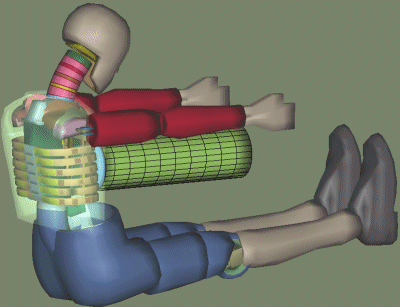Occupant Safety Assessment and Crash Biomechanics
Background
During crashes, vehicle occupants may experience a wide variety of injuries that often correspond to their location within the vehicle, their age and gender, and type of vehicle and crash. Current finite-element models that are used to assess the level of injuries employ only 60,000 to 100,000 elements and require 12 hours of computation to assess vehicle structural components. Occupant models mostly represent the "50% adult male" (i.e., average-size male). However, models representative of the "95% adult male" (larger in size than 95% of adult male population), "5% adult female" (smaller in size than 95% of adult female population), child, and infant vehicle occupants are required for a complete assessment of crash scenarios.
Role of High-Performance Computing
High-fidelity models, such as THUMS (Total Human Model for Safety), present detailed anatomical components of the human body. The highest level of biomechanical modeling uses the anatomically correct structures of vehicle occupants to assess trauma to the brain, internal organs, joints, and skeletal system during crashes. High-fidelity modeling can add 80,000+ elements per occupant and assess up to four passengers per vehicle, for a total of 320,000 elements. This information can be used to develop and improve mechanisms that can increase the levels of passenger safety protection for all sizes of occupants within the vehicles.

Crash test dummies represent full-scale replicas of human beings and are instrumented to record data during crash tests. A finite-element model of the 50th percentile male Hybrid III crash test dummy is shown during a numerical simulation of impact to the chest (Figure provided by Livermore Software Technology Corporation). The use of calibrated finite-element models of occupants in crash simulations provides accurate prediction of occupant injuries.
Contact: This email address is being protected from spambots. You need JavaScript enabled to view it.- Computational Structural Mechanics Engineer